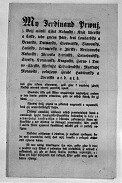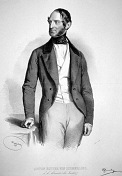Important days
3. 3. 2011
The February Constitution
Constitutional Developments in the Hapsburg Monarch
The Austrian monarchy, the same as a number of other European countries, was affected by the revolutionary movement led by liberal, educated burghers claiming an expansion of their rights in 1848. Under the pressure of events, the head of the Austrian monarchy, Ferdinand V, was forced to issue the very first Austrian constitution. It was issued on 25 April 1848 and is usually called the Pillersdorf Constitution, after its author, Minister of the Interior Franz von Pillersdorf. As it was issued by the monarch and not passed by a constitutive assembly, we can call it an octroyed or imposed constitution. The Pillersdorf Constitution as a whole never applied in practice, although elections to a constituent assembly, called after the place where it met, Kroměříž, were held in its spirit.
The Reichstag meeting from July 1848 had as its main aim the drafting and approval of a new constitution that would no longer be imposed. It approached this task responsibly and, during its eight-month lifetime, looked at the matters of a new constitution extensively. The whole effort, however, could not be completed, as the new Emperor Franz Joseph I strengthened his position by defeating the revolutionaries and decided to dissolve the assembly at the start of March 1849. The project for a constitutional document therefore remained on paper.
At the same time as the assembly was dissolved, the text of a new constitution was published. The same as the Pillersdorf Constitution, it was an octroyed constitution. It was called after its main drafter, Minister of the Interior Franz Stadion.
From its issue, the constitution was regarded as a diversionary manoeuvre through which the emperor tried to calm the population disappointed by the dissolution of the Kroméříž assembly.
The objection that is was only a fig leaf for absolutism was finally proved at the end of 1851, when it was repealed by the New Year’s Eve patents. Austria returned to a system where all power in the empire was wielded by the emperor.
The Schmerling Constitution
The subsequent period, called neoabsolutism, ended in 1859. The Austrian army suffered a devastating defeat in the war with the forces unifying Italy, supported by France. The military debacle was accompanied by the collapse of government finances. The emperor was forced to convene the Reichsrat, a body in which, in addition to others, rich financiers who could help the failing government sat. In return for this help, however, they requested control of government power, primarily finances. This started the journey to the full renewal of constitutionality. The emperor issued the “October Diploma” on 20 October 1860, promising a return to constitutionality and parliamentarianism.
The promises made in the October Diploma were met to a marked extent by the acceptance of a constitution in February 1861. It was called the February or Schmerling Constitution, after Minister Anton von Schmerling. It was again an octroyed constitution. It is interesting that it was not published in the form of one document, as we are used to today, but that the various provisions were published in the form of a patent, supplemented by a whole number of annexes. A bicameral parliament called the Reichsrat obtained legislative power. The body comprised two chambers, the Houses of Lords and Deputies. Adult princes of the Hapsburg dynasty, the high nobility and church dignitaries were entitled to sit in the House of Lords. The emperor also had the right to name certain deserving persons life members of the House of Lords. The House of Deputies was to meet in two forms—a wider one, where representatives of Hungary and Lombardy were also present, and a narrower one, which did not include these deputies. Due to resistance from representatives of the eastern part of the empire, the Reichsrat never met in the wider form and only operated in its narrower form. Deputies, elected for a six-year term, were not elected to the Reichsrat directly by the voters, but through provincial assemblies.
The December Constitution
Another impulse for the development of constitutionality was the defeat of the Austrian armies at the Battle of Königgrätz (Hradec Králové) in 1866. As a consequence of the internal instability, political leaders in the monarchy looked for a solution enabling the multi-national empire to continue to exist. The talks resulted in the Austro-Hungarian Compromise. Thanks to it, the Hungarians obtained a very strong position. We can say that in practice it divided the single Austrian empire into two units, called Cisleithania and Transleithania. These changes were understandably reflected in the empire’s fundamental law. The Schmerling Constitution was amended in December 1967. The amendment reflected political shifts in the country.
Further amendments were made to the constitution until the end of the monarchy’s existence. The introduction of universal suffrage, which occurred in 1907, was regarded as the most significant change. This reform is sometimes called the Beck reform, after Prime Minister Max Beck. It enabled all men over 24 to vote without any property restrictions, which was a significant breakthrough in contemporary customs.








